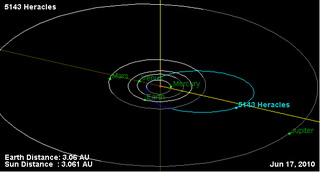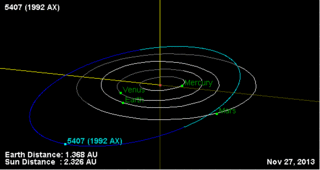Related Research Articles
2063 Bacchus, provisional designation 1977 HB, is a stony asteroid and near-Earth object of the Apollo group, approximately 1 kilometer in diameter. The contact binary was discovered on 24 April 1977, by American astronomer Charles Kowal at the Palomar Observatory in California, United States. It was named after Bacchus from Roman mythology.
3352 McAuliffe, provisional designation 1981 CW, is a rare-type asteroid and suspected binary system, classified as near-Earth object of the Amor group, approximately 2 kilometers in diameter. It was discovered on 6 February 1981, by American astronomer Norman Thomas at Lowell's Anderson Mesa Station near Flagstaff, Arizona, United States.
(68950) 2002 QF15 is a stony asteroid, classified as near-Earth object and potentially hazardous asteroid of the Apollo group, that measures approximately 2 kilometers in diameter. It was discovered on 27 August 2002, by the LINEAR project at Lincoln Laboratory's Experimental Test Site in Socorro, New Mexico, United States.

2100 Ra-Shalom is an asteroid and near-Earth object of the Aten group on an eccentric orbit in the inner Solar System. It was discovered on 10 September 1978, by American astronomer Eleanor Helin at the Palomar Observatory, California, who named it in commemoration of the Camp David Peace Accords. The C-type asteroid has a rotation period of 19.8 hours and measures approximately 2.7 kilometers in diameter.
1866 Sisyphus is a binary stony asteroid, near-Earth object and the largest member of the Apollo group, approximately 7 kilometers in diameter.

1627 Ivar, provisional designation 1929 SH, is an elongated stony asteroid and near-Earth object of the Amor group, approximately 15×6×6 km. It was discovered on 25 September 1929, by Danish astronomer Ejnar Hertzsprung at Leiden Southern Station, annex to the Johannesburg Observatory in South Africa. It was named after Ivar Hertzsprung, brother of the discoverer. 1627 Ivar was the first asteroid to be imaged by radar, in July 1985 by the Arecibo Observatory.
1065 Amundsenia, provisional designation 1926 PD, is a stony asteroid and sizeable Mars-crosser on an eccentric orbit from the inner asteroid belt, approximately 10 kilometers in diameter. It was discovered on 4 August 1926, by Soviet astronomer Sergey Belyavsky at the Simeiz Observatory on the Crimean peninsula. The asteroid was named after Norwegian polar explorer Roald Amundsen.

1103 Sequoia is a bright Hungaria asteroid from the innermost region of the asteroid belt, approximately 7 kilometers in diameter. It was discovered on 9 November 1928, by German astronomer Walter Baade at the Bergedorf Observatory in Hamburg, Germany, who named it after the Sequoia National Park located in California.
(9992) 1997 TG19 is a stony asteroid and eccentric Mars-crosser, approximately 4 kilometers in diameter. It was discovered on 8 October 1997, by Japanese astronomers Tetsuo Kagawa and Takeshi Urata at Gekko Observatory near Shizuoka, Japan.
4450 Pan is a highly eccentric asteroid and contact binary, classified as a potentially hazardous asteroid and near-Earth object of the Apollo group, approximately 1.1 kilometers in diameter. It was discovered on 25 September 1987, by American astronomers Eugene and Carolyn Shoemaker at Palomar Observatory in California, United States. It was named after Pan from Greek mythology.
1943 Anteros, provisional designation 1973 EC, is a spheroidal, rare-type asteroid and near-Earth object of the Amor group, approximately 2 kilometers in diameter.
1717 Arlon, provisional designation 1954 AC, is a binary Florian asteroid from the inner regions of the asteroid belt, approximately 8.5 kilometers in diameter.

5143 Heracles, provisional designation 1991 VL, is a highly eccentric, rare-type asteroid and synchronous binary system, classified as near-Earth object of the Apollo group, approximately 4.8 kilometers in diameter. The asteroid was discovered on 7 November 1991, by American astronomer Carolyn Shoemaker at Palomar Observatory in California, United States. It is named for the Greek divine hero Heracles. It has an Earth minimum orbit intersection distance of 0.058 AU (8.7 million km) and is associated with the Beta Taurids daytime meteor shower.
7088 Ishtar, provisional designation 1992 AA, is a synchronous binary asteroid and near-Earth object from the Amor group, approximately 1.3 kilometers in diameter. It was discovered on 1 January 1992, by American astronomer Carolyn Shoemaker at the Palomar Observatory in California. The relatively bright asteroid with an unknown spectral type has a rotation period of 2.7 hours. In December 2005, a 330-meter sized satellite was discovered, orbiting its primary every 20.65 hours.
4055 Magellan, provisional designation 1985 DO2, is a bright and eccentric asteroid and near-Earth object of the Amor group, approximately 2.5 kilometers in diameter. It was discovered on 24 February 1985, by American astronomer Eleanor Helin at Palomar Observatory in California, United States. It was later named for Portuguese explorer Ferdinand Magellan.
3066 McFadden, provisional designation 1984 EO, is a stony background asteroid from the central regions of the asteroid belt, approximately 15 kilometers in diameter. It was discovered on 1 March 1984, by American astronomer Edward Bowell at the Anderson Mesa Station near Tucson, Arizona. It was named for American planetary scientist Lucy-Ann McFadden. The assumed S-type asteroid has a rotation period of 13.8 hours.

1980 Tezcatlipoca, provisional designation 1950 LA, is an eccentric, stony asteroid and near-Earth object of the Amor group, approximately 6 kilometers (4 mi) in diameter.

(5407) 1992 AX, provisional designation 1992 AX, is a stony asteroid and a synchronous binary Mars-crosser from the innermost region of the asteroid belt, approximately 3.6 kilometers in diameter. It was discovered on 4 January 1992, by Japanese astronomers Seiji Ueda and Hiroshi Kaneda at the Kushiro Observatory on Hokkaidō, Japan. The S-type asteroid has a short rotation period of 2.5 hours. Its sub-kilometer satellite was discovered in 1997. As of 2018, the binary system has not been named.
(5836) 1993 MF is a highly eccentric, stony asteroid, classified as a near-Earth object of the Amor group of asteroids, approximately 3 kilometers in diameter. It was discovered on 22 June 1993, by American astronomers Eleanor Helin and Kenneth Lawrence at the U.S. Palomar Observatory in California.
(10115) 1992 SK, is a stony near-Earth object and potentially hazardous asteroid on an eccentric orbit. It belongs to the group of Apollo asteroids and measures approximately 1 kilometer in diameter. It was discovered by American astronomers Eleanor Helin and Jeff Alu at the Palomar Observatory in California on 24 September 1992.
References
- 1 2 3 4 5 6 "JPL Small-Body Database Browser: 86039 (1999 NC43)" (2014-06-24 last obs.). Jet Propulsion Laboratory . Retrieved 1 June 2017.
- 1 2 3 4 5 "86039 (1999 NC43)". Minor Planet Center. Retrieved 1 March 2016.
- 1 2 3 4 Usui, Fumihiko; Kuroda, Daisuke; Müller, Thomas G.; Hasegawa, Sunao; Ishiguro, Masateru; Ootsubo, Takafumi; et al. (October 2011). "Asteroid Catalog Using Akari: AKARI/IRC Mid-Infrared Asteroid Survey". Publications of the Astronomical Society of Japan. 63 (5): 1117–1138. Bibcode:2011PASJ...63.1117U. doi:10.1093/pasj/63.5.1117. (online, AcuA catalog p. 153)
- 1 2 3 4 Delbó, Marco; Harris, Alan W.; Binzel, Richard P.; Pravec, Petr; Davies, John K. (November 2003). "Keck observations of near-Earth asteroids in the thermal infrared". Icarus. 166 (1): 116–130. Bibcode:2003Icar..166..116D. doi:10.1016/j.icarus.2003.07.002 . Retrieved 1 March 2016.
- 1 2 3 Delbo, Marco; Walsh, Kevin; Mueller, Michael; Harris, Alan W.; Howell, Ellen S. (March 2011). "The cool surfaces of binary near-Earth asteroids". Icarus. 212 (1): 138–148. Bibcode:2011Icar..212..138D. doi:10.1016/j.icarus.2010.12.011 . Retrieved 1 March 2016.
- 1 2 Warner, Brian D. (July 2014). "Near-Earth Asteroid Lightcurve Analysis at CS3-Palmer Divide Station: 2014 January–March". The Minor Planet Bulletin. 41 (3): 157–168. Bibcode:2014MPBu...41..157W. ISSN 1052-8091 . Retrieved 1 March 2016.
- 1 2 Warner, Brian D. (October 2014). "Near-Earth Asteroid Lightcurve Analysis at CS3-Palmer Divide Station: 2014 March–June". The Minor Planet Bulletin. 41 (4): 213–224. Bibcode:2014MPBu...41..213W. ISSN 1052-8091 . Retrieved 1 March 2016.
- 1 2 3 "LCDB Data for (86039)". Asteroid Lightcurve Database (LCDB). Retrieved 1 March 2016.
- ↑ Veres, Peter; Jedicke, Robert; Fitzsimmons, Alan; Denneau, Larry; Granvik, Mikael; Bolin, Bryce; et al. (November 2015). "Absolute magnitudes and slope parameters for 250,000 asteroids observed by Pan-STARRS PS1 - Preliminary results". Icarus. 261: 34–47. arXiv: 1506.00762 . Bibcode:2015Icar..261...34V. doi:10.1016/j.icarus.2015.08.007 . Retrieved 26 May 2016.
- ↑ "MPEC 1999-O15 : 1999 NC43". IAU Minor Planet Center. 19 July 1999. Retrieved 9 November 2013. (J99N43C)
- ↑ "JPL Close-Approach Data: 86039 (1999 NC43)" . Retrieved 9 November 2013.
- ↑ "JPL Small-Body Database Search Engine: spec. type = Q (SMASSII)". JPL Solar System Dynamics. Retrieved 1 March 2016.
- ↑ Borovička, Jiří; Spurný, Pavel; Brown, Peter; Wiegert, Paul; Kalenda, Pavel; Clark, David; et al. (November 2013). "The trajectory, structure and origin of the Chelyabinsk asteroidal impactor". Nature. 503 (7475): 235–237. Bibcode:2013Natur.503..235B. doi:10.1038/nature12671. PMID 24196708 . Retrieved 1 March 2016.
- ↑ Schiermeier, Quirin. "Risk of massive asteroid strike underestimated". Nature News. Nature Publishing Group . Retrieved 7 November 2013.
- ↑ "MPC/MPO/MPS Archive". Minor Planet Center. Retrieved 24 February 2018.